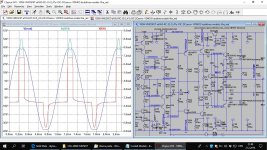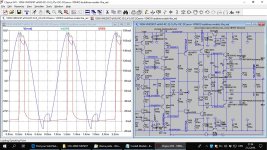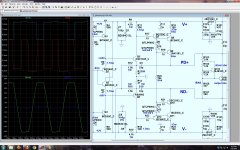Nice overview, thanks!
Jan
Cheers Jan, Dave and Mlloyd.
Last edited:
Here is example how my CFA clips, no need for clamp diode.
Enhanced VAS is symmetric and as this configuration is current on demand it's not possible to use VAS current limiting approach, but prevent the EF part of the enhanced VAS to go to high current at the clipping. This is solved with resistor added in the EF collector (R20, R24 in Q14, Q2 collectors).
In my opinion, missing this resistor in Self enhanced VAS is big mistake he never corrected not even in his 6th edition.
I built some of his blameless amps and burned some VAS transistors wile clipping. Solved it with additional collector resistor long time ago, in time he wrote his amplifier distortion articles in WW.
Attached two clipping cases, with and without (or to small value) collector resistors.
Enhanced VAS is symmetric and as this configuration is current on demand it's not possible to use VAS current limiting approach, but prevent the EF part of the enhanced VAS to go to high current at the clipping. This is solved with resistor added in the EF collector (R20, R24 in Q14, Q2 collectors).
In my opinion, missing this resistor in Self enhanced VAS is big mistake he never corrected not even in his 6th edition.
I built some of his blameless amps and burned some VAS transistors wile clipping. Solved it with additional collector resistor long time ago, in time he wrote his amplifier distortion articles in WW.
Attached two clipping cases, with and without (or to small value) collector resistors.
Attachments
I burned more than just the VAS transistors. The whole amp let out the Holy Smoke on overload.... but prevent the EF part of the enhanced VAS to go to high current at the clipping. This is solved with resistor added in the EF collector (R20, R24 in Q14, Q2 collectors).
In my opinion, missing this resistor in Self enhanced VAS is big mistake he never corrected not even in his 6th edition.
I built some of his blameless amps and burned some VAS transistors wile clipping.
I mentioned this when Self was asking for suggestions for his 6th edition but it looks like he is ignoring this Holy Smoke issue.
Very interesting, he snubbed me a few years back, when I offered to do up a layout of that design, just for the fun of it, good thing I did not bother.I mentioned this when Self was asking for suggestions for his 6th edition but it looks like he is ignoring this Holy Smoke issue.
bulletproof VAS
They (builders) just built some more of these.
First thing they do is apply 4V input.
Must be fun !!
At least it will survive (and alternately flash D9-12).
I like how the Boxall pair ( Baxandall/ IP thief )- pair ..
pair ..
shuts off. Cold VAS with gross overload.
"Mates" good with the CFA , "gain city".
The "pitchfork villager" favorite of all my 20 IPS's
OS
They (builders) just built some more of these.
First thing they do is apply 4V input.
Must be fun !!
At least it will survive (and alternately flash D9-12).
I like how the Boxall pair ( Baxandall/ IP thief )-
shuts off. Cold VAS with gross overload.
"Mates" good with the CFA , "gain city".
The "pitchfork villager" favorite of all my 20 IPS's
OS
Attachments
Well it works dadod - good one!
From 2007:
https://www.diyaudio.com/forums/sol...chwork-product-simulation-10.html#post1312476
I was pleased to find chapter 8 "The Push-Pull Voltage Amplifier Stage" in the Sixth edition
because I plan to do some experimenting with them. The first example is the Hitachi
MOSFET front end that in my opinion should be called a differential VAS as is also used in
the Otalla, Cordell's old MOSFET design, Symasym and many others. I think of push-pull
as a single transistor with or without beta multiplier and/or a cascode and complement. It
can be driven by a simple diff pair or comp diff pairs. I expected to find something like the
Apt-1 for his example of a single diff pair front end driving a push-pull VAS:
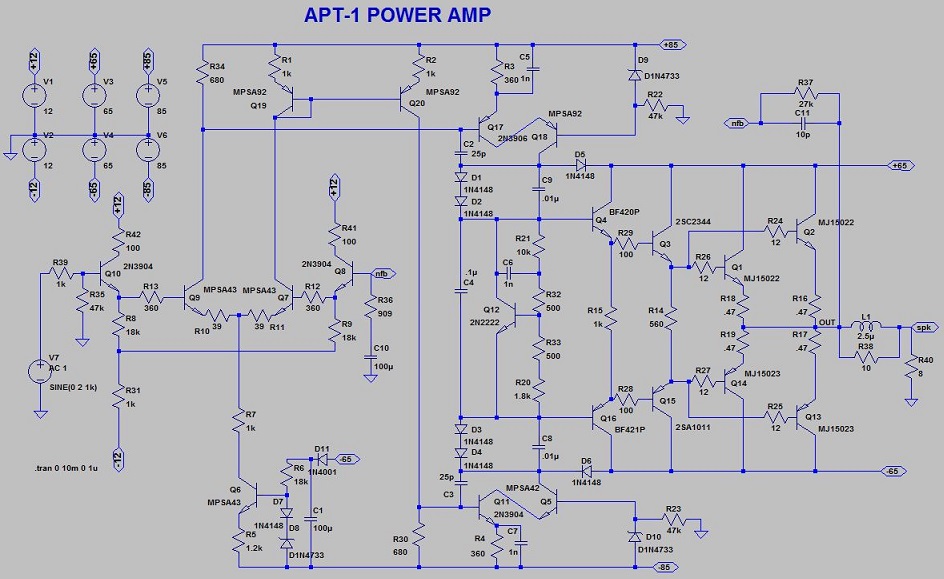
I posted simulation files for the APT-1 in this new thread:
APT-1 Schematic and Simulation from unclejed613
Next, after pointing out the issues with the Hitachi front end he moves onto the Lender
design and points out the issues with it. I appreciate and learn from reading about the
issues with poor designs but how about a good one? I've not dug into the many Japanese
designs that are similar to the APT-1 but am interested to learn about some of the best.
Self then moves onto the dual diff front ends which don't interest me due to the
(unnecessary IMO) complexity.
He also covers the Series Differential input, and Folded Cascode configurations to his credit.
because I plan to do some experimenting with them. The first example is the Hitachi
MOSFET front end that in my opinion should be called a differential VAS as is also used in
the Otalla, Cordell's old MOSFET design, Symasym and many others. I think of push-pull
as a single transistor with or without beta multiplier and/or a cascode and complement. It
can be driven by a simple diff pair or comp diff pairs. I expected to find something like the
Apt-1 for his example of a single diff pair front end driving a push-pull VAS:
I posted simulation files for the APT-1 in this new thread:
APT-1 Schematic and Simulation from unclejed613
Next, after pointing out the issues with the Hitachi front end he moves onto the Lender
design and points out the issues with it. I appreciate and learn from reading about the
issues with poor designs but how about a good one? I've not dug into the many Japanese
designs that are similar to the APT-1 but am interested to learn about some of the best.
Self then moves onto the dual diff front ends which don't interest me due to the
(unnecessary IMO) complexity.
He also covers the Series Differential input, and Folded Cascode configurations to his credit.
Last edited:
Another early (mid 70's) example of a push-pull VAS is the Marantz 510, it has several
nice features. Diff pair transistor with degeneration (not that common back then),
Edit: the dotted line around the diff pair transistors seems to indicate thermal coupling
rather than a dual.
beta multiplier, input buffering. The input buffering could have provided for driving the
non-inverting input for lower distortion but they didn't do it:
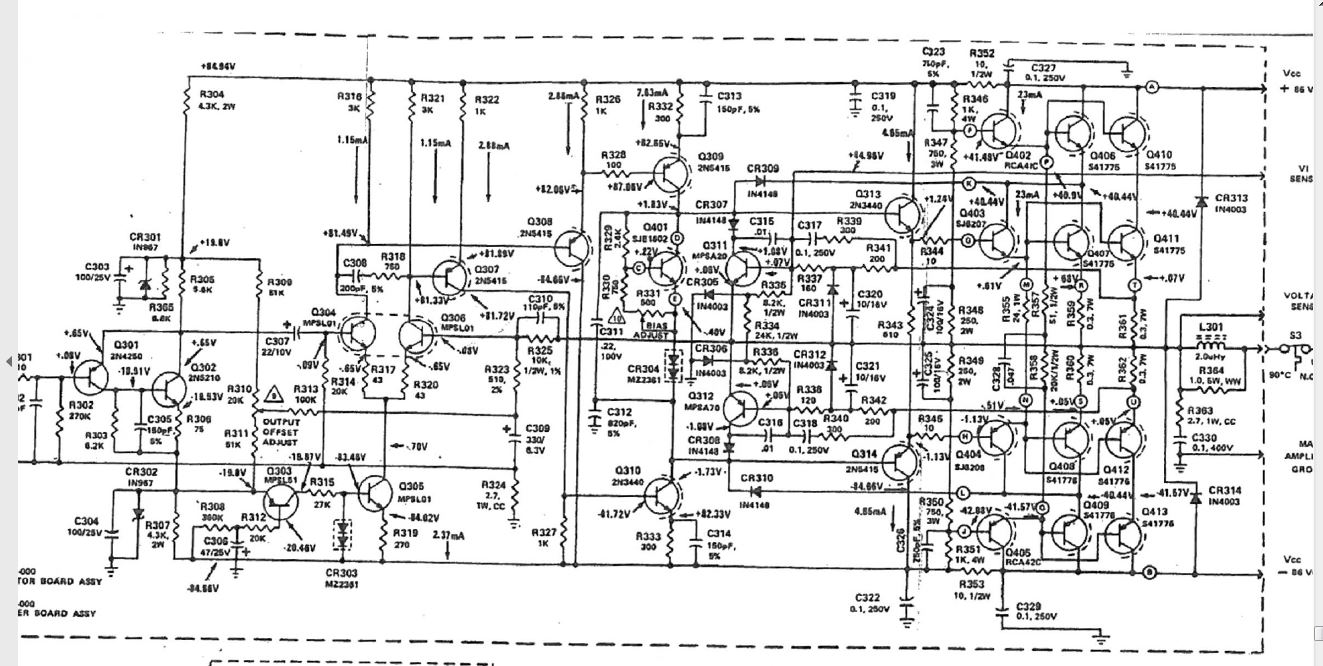
nice features. Diff pair transistor with degeneration (not that common back then),
Edit: the dotted line around the diff pair transistors seems to indicate thermal coupling
rather than a dual.
beta multiplier, input buffering. The input buffering could have provided for driving the
non-inverting input for lower distortion but they didn't do it:
Last edited:
carlmart here on diyaudio points out that the Luxman M-120 is very similar to the APT-1:
https://www.diyaudio.com/forums/sol...mp-undeservedly-forgotten-37.html#post6015692
https://www.diyaudio.com/forums/sol...mp-undeservedly-forgotten-37.html#post6015692
The input buffering could have provided for driving the
non-inverting input for lower distortion but they didn't do it]
non-inverting above should have been inverting.
Self mentions that folded cascode designs are most often found in OP amps and that one
power amp implementation is found here in "Explendid amplifier designed by Michael Bittner, our MikeB":
Explendid amplifier designed by Michael Bittner, our MikeB
This thread however is mostly about a diff pair VAS Symasym design. There is a post where
it is stated that the design is very similar to the Dynaco 400 which also employs a diff-pair
VAS. Neither are folded cascodes.
The folded cascode schematic is shown in this post, Focasym:
https://www.diyaudio.com/forums/sol...esigned-michael-bittner-mikeb.html#post683544
But most of the discussion is not about Focasym, until page 7:
Explendid amplifier designed by Michael Bittner, our MikeB
Where in post #61 MikeB writes:
"Yes, the folded cascode is faster, but the highgainversion sounded
better. The problem with the foldedcascode version was that because
of the low gain the tanh() nature of the 1st diffamp got dominant
in distortionfigures and created too much 3rd harmonic distortion.
This yielded in a unpleasant/unmusical sound."
Certainly the design could be improved but I've not read the entire, long, thread and
have not found any discussion so far. Went to the end of the thread and the talk was
still about Symasym5 not a folded cascode design.
Anyone know of a good, proven, folded cascode power amp design?
power amp implementation is found here in "Explendid amplifier designed by Michael Bittner, our MikeB":
Explendid amplifier designed by Michael Bittner, our MikeB
This thread however is mostly about a diff pair VAS Symasym design. There is a post where
it is stated that the design is very similar to the Dynaco 400 which also employs a diff-pair
VAS. Neither are folded cascodes.
The folded cascode schematic is shown in this post, Focasym:
https://www.diyaudio.com/forums/sol...esigned-michael-bittner-mikeb.html#post683544
But most of the discussion is not about Focasym, until page 7:
Explendid amplifier designed by Michael Bittner, our MikeB
Where in post #61 MikeB writes:
"Yes, the folded cascode is faster, but the highgainversion sounded
better. The problem with the foldedcascode version was that because
of the low gain the tanh() nature of the 1st diffamp got dominant
in distortionfigures and created too much 3rd harmonic distortion.
This yielded in a unpleasant/unmusical sound."
Certainly the design could be improved but I've not read the entire, long, thread and
have not found any discussion so far. Went to the end of the thread and the talk was
still about Symasym5 not a folded cascode design.
Anyone know of a good, proven, folded cascode power amp design?
Last edited:
As a guitarist, I like an amplifier to give predominently 2nd order distortion. That doesnt occur in op amp inspired power amplifiers. I have simulated a single cascode input stage which according to MC12, which does that and is extremely fast up to 100 Khz. I will build it and share it this year
Finally, Self mentions Samuel Groner's "A New Amplifier Topology With Push Pull
Transimpedance Stage" in Linear Audio Volume 2, September 2011. I offer some
comments on the article here:
https://www.diyaudio.com/forums/sol...o-amplifier-topology-article.html#post6041407
Transimpedance Stage" in Linear Audio Volume 2, September 2011. I offer some
comments on the article here:
https://www.diyaudio.com/forums/sol...o-amplifier-topology-article.html#post6041407
- Status
- This old topic is closed. If you want to reopen this topic, contact a moderator using the "Report Post" button.
- Home
- Amplifiers
- Solid State
- Audio Power Amplifier by Douglas Self
